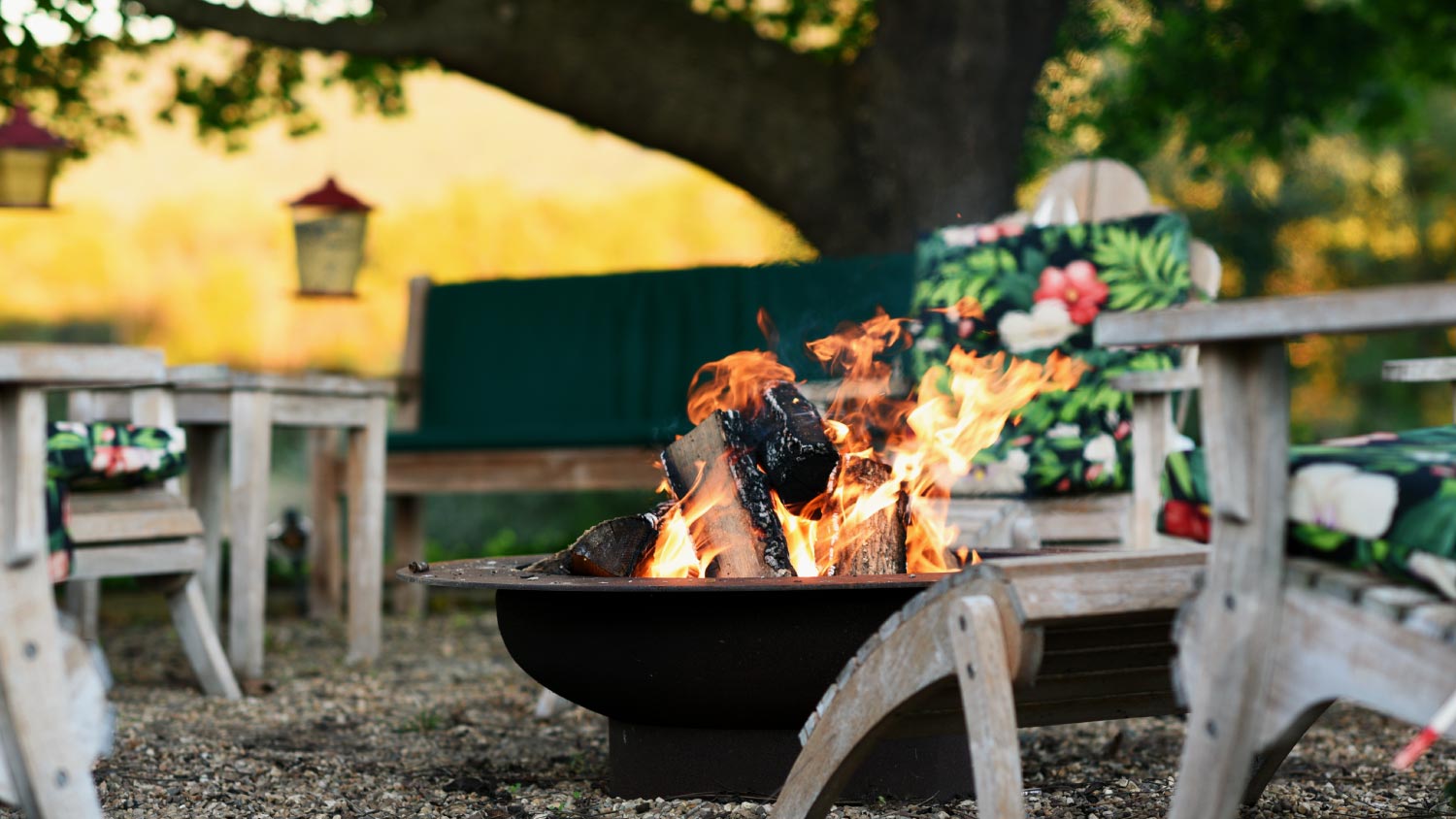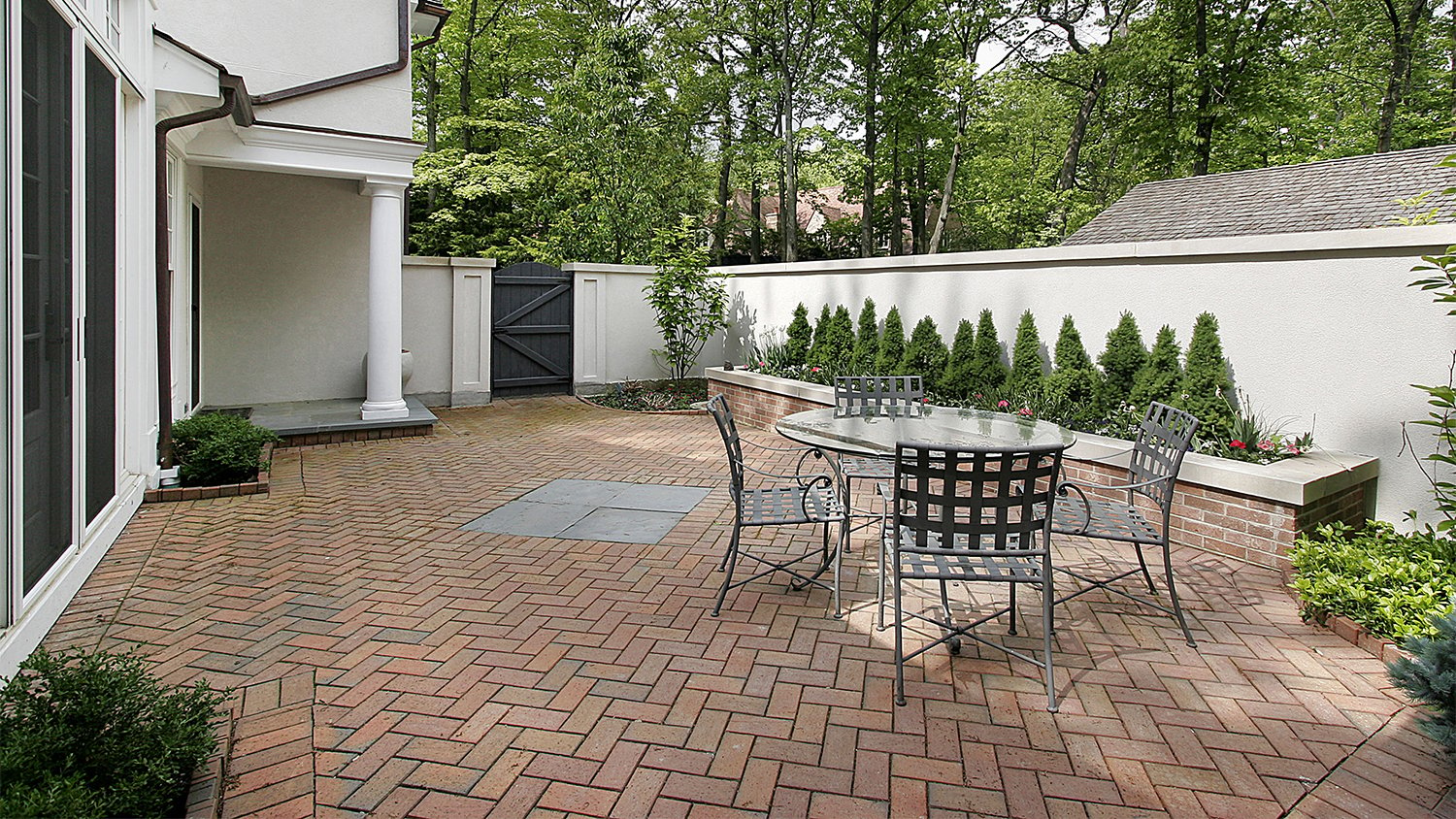Is a Gas or Wood Fire Pit Right for Your Home?
Is one s’more attractive than the other?


Simple wood fire pits are inexpensive and can be a DIY weekend task.
You can cook on wood fire pits, but not all gas fire pits can be used for cooking.
Gas fire pits are low-maintenance, environmentally friendly, and smoke-free.
Gas fire pits require professional installation.
Both add instant ambiance to your backyard and create a cozy spot for gatherings.
If chestnuts roasting on an open fire is sounding pretty good right now, you’re probably in the market for a fire pit for your backyard. A fire pit will not only bring ambiance to your yard, but it will also expand the use of an outdoor space into the cooler months. The big question, though, is what kind of fire pit is right for you, gas or wood-burning?
What’s the Difference Between a Gas Fire Pit and a Wood Fire Pit?
Just like an indoor fireplace, when it comes to choosing your outdoor fire pit, you will need to decide between gas or wood.
Wood Fire Pits
Can be simple, like a small brick pit or fancy, like an elaborate, custom stone fireplace
Use wood for fuel
Must be extinguished completely with water to ensure coals do not spark a fire
Gas Fire Pits
Are operated via an electric switch and powered by natural gas, usually propane
Can be smaller with a tank that you refill and change yourself, or an extensive gas fire pit system built directly into your custom landscaping
Gas Fire Pit Pros & Cons

When it comes to convenience, gas fire pits definitely win out over a wood fire pit. Rather than toil over the kindling-to-newspaper ratio to get your fire going, you just flick a switch, and voila! Your fire is on. Gas fire pits aren’t all glory, though.
Here are some of the key pros and cons of a gas fire pit.
Pros
Instant fire, often at the touch of a button, switch, or remote control
Easy to operate
Low to no cleanup
Smoke-free, which can be a big perk for young kids or people with allergies or asthma
No smoke smell on clothes or hair
Adds ambiance to your yard
Less fire danger (note there is always some fire danger with an open flame present)
Cons
More extensive installation process
Gas tanks need to be refilled
Generally cost more than wood fire pits
Fires tend to be smaller
Not all gas fire pits are suitable for cooking
Wood Fire Pit Pros & Cons

While gas fire pits may win out in the convenience department, there is nothing like a wood fire pit. It has a nostalgic ambiance that can’t be beat. Overall they tend to be less expensive than installing a gas fire pit, too.
Before you fan the flames, though, you’ll want to know some of the pros and cons of installing a wood fire pit.
Pros
Bigger fires
More traditional ambiance (aka the crackling of the wood)
Inexpensive
You can install a simple wood fire pit yourself
You can definitely cook over it (hello, s’mores!)
Cons
You need fire building skills (aka not instantaneous)
More cleanup (ash, coals)
More safety issues, such as unattended embers starting fires
The smell of smoke gets on clothing and hair
Adding smoke to the atmosphere
You need space for storing and curing wood
Stacks of wood can attract rodents
A wood fire pit may require a permit, and burning wood fires may be prohibited on certain days
Gas Fire Pit vs. Wood Fire Pit
While the heat is still on in this competition, both gas fire pits and wood fire pits offer plenty of pros, with a few cons. If you’re still trying to decide, there are a few more factors to consider.
Appearance: Tie
There’s nothing quite like a fire to add atmosphere to your yard. Custom stonework or a portable pit with intricate metal patterns can up the wow factor for any wood fire. Gas pits tend to have some degree of custom work, giving them a unique, attractive appearance that will fit your style.
Options & Customizations: Tie
From an outdoor fireplace with two-way glass to a bonfire pit surrounded by stones, there are many options for both types of fire pits. Gas fire pits are more frequently customized as they are often part of a larger landscape patio design.
Durability: Tie
If properly installed and maintained, both types of fire pits will last for many years.
Gas fire pits that are made from long-lasting metals, such as steel, are especially durable if they are kept clean and covered during extreme weather or when not in use.
Bricks can last 50 years or more, so a well-made outdoor brick fireplace or pit can last at least that long, though it will likely need repairing along the way.
Price: Wood Fire Pit
The cost of installing a fire pit can vary greatly. A simple outdoor fire pit you build yourself can be as little as $200. On the higher end, custom stonework fireplaces can start at $8,000.
Prefabricated gas fireplaces require professional installation and range from $750 to $6,000. Depending on the location of your fire pit, any additional gas pipelines can cost $25 per linear foot to install.
Ease of Installation/DIY-ability: Wood Fire Pit
A basic stone or brick fire pit is easy to build. Portable metal fire pits are even easier. Gas fire pits cost more and require professional installation due to the pipelines.
Eco-Friendliness/Sustainability: Gas Fire Pits
Wood-burning fire pits not only add smoke to the atmosphere, but they also require harvested wood, aka cut-down trees. However, there are more sustainable alternatives to wood, including recycled, compressed wood eco-logs, or even logs made from coffee grounds.
Gas fire pits do not produce smoke and are usually very energy efficient. In addition, they are less of a fire hazard as they don’t produce sparks or embers.
ROI/Resale Value: Gas Fire Pits
If your fire pit is more than a simple hole in the ground, it can add value to your home. Fire pits using natural gas tend to add the most value, especially when combined with an outdoor patio or living space.
Overall Winner: Tie
While wood fire pits have definite advantages in terms of cost and ease of installation, gas fire pits score points for being super convenient and more environmentally friendly. Overall, they both win for ambiance, adding value, and the ability to customize.
Backyard Fire Pit Safety Tips
Whether you go with a gas fire pit or a wood fire pit, before you install one on your property, you need to keep a few fire pit safety tips in mind.
Check for local restrictions and regulations on where you can place your fire pit.
Always make sure your fire pit is at least 10 feet away from any structure on your property, including landscaping.
Trim any nearby trees and landscaping.
Clean up dried leaves and branches in the area before lighting your fire.
Always extinguish fires after use.
Keep small children and pets away from open flames unless closely supervised.
Be sure the fire pit walls are high enough to prevent small children from falling in, at least that children or pets could not fall in.
Keep water and a fire extinguisher nearby.
Make sure your home’s sprinkler system is up to date.





- Is a Fire Pit Under a Pergola Safe? What to Know Before You Start Roasting Marshmallows
- 22 Fire Pit Ideas for Your Backyard, Patio, Deck, and More
- 6 Reasons Why You Should Warm Up to a Backyard Fire Pit
- Play It Safe With These Must-Know Fire Pit Safety Tips
- What's Hot! Fire Pit Trend Blazes Through Charlotte, Landscapers Say
- How to Build a Fireproof House From the Foundation to the Roof
- 18 Fire Pit Seating Ideas
- Who Can Install Fire Doors? An Installation Hiring Guide
- 7 Effective Ways to Fireproof Your Home, From Siding to Doors
- How Long It Takes for a House to Burn Down and Why Newer Homes Burn Faster










